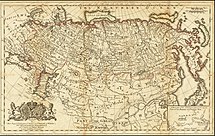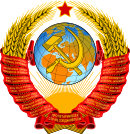
Back تاريخ الاتحاد السوفييتي Arabic Historia de la Xunión Soviética AST SSRİ tarixi Azerbaijani История на Съветския съюз Bulgarian Història de la Unió Soviètica Catalan مێژووی یەکێتیی سۆڤیەت CKB Dějiny Sovětského svazu Czech Sovjetunionens historie Danish Geschichte der Sowjetunion German Historia de la Unión Soviética Spanish
| Part of a series on the |
| History of the Soviet Union |
|---|
 |
|
|
| History of Russia |
|---|
 |
|
|
| Part of a series on the |
| Culture of the Soviet Union |
|---|
 |
| People |
| Languages |
| Traditions |
| Cuisine |
| Festivals |
| Literature |
| Music |
| Sport |
The history of Soviet Russia and the Soviet Union (USSR) reflects a period of change for both Russia and the world. Though the terms "Soviet Russia" and "Soviet Union" often are synonymous in everyday speech (either acknowledging the dominance of Russia over the Soviet Union or referring to Russia during the era of the Soviet Union), when referring to the foundations of the Soviet Union, "Soviet Russia" often specifically refers to brief period between the October Revolution of 1917 and the creation of the Soviet Union in 1922.
Before 1922, there were four independent Soviet Republics: the Russian Soviet Federative Socialist Republic, Ukrainian Soviet Socialist Republic, Byelorussian SSR, and Transcaucasian SFSR. These four became the first Union Republics of the Soviet Union, and was later joined by the Bukharan People's Soviet Republic and Khorezm People's Soviet Republic in 1924. During and immediately after World War II, various Soviet Republics annexed portions of countries in Eastern Europe, and the Russian SFSR annexed the Tuvan People's Republic, and from the Empire of Japan took South Sakhalin and the Kuril Islands. The USSR also annexed three countries on the Baltic Sea wholesale, creating the Lithuanian SSR, Latvian SSR, and Estonian SSR. Over time, national delimitation in the Soviet Union resulted in the creation of several new Union-level Republics along ethnic lines, as well as organization of autonomous ethnic regions within Russia.
The USSR gained and lost influence with other Communist countries over time. The occupying Soviet army facilitated the establishment of post-WWII Communist satellite states in Central and Eastern Europe. These were organized into the Warsaw Pact, and included the People's Socialist Republic of Albania, People's Republic of Bulgaria, Czechoslovak Socialist Republic, East Germany, Hungarian People's Republic, Polish People's Republic, and Socialist Republic of Romania. The 1960s saw the Soviet–Albanian split, Sino-Soviet split, and de-satellization of Communist Romania; the 1968 Warsaw Pact invasion of Czechoslovakia fractured the communist movement. The Revolutions of 1989 ended Communist rule in satellite countries.
Tensions with the central government led to constituent republics declaring independence starting in 1988, leading to the complete dissolution of the Soviet Union by 1991.